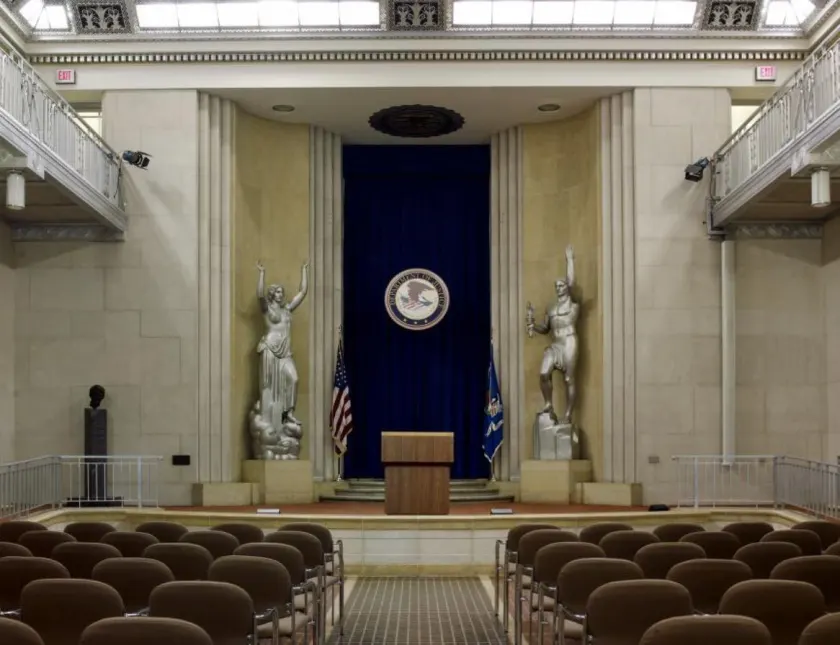A Florida charter school principal was forced to resign last week after a photograph of Michelangelo’s David was shown in a sixth grade art class. Hope Carrasquilla of the Tallahassee Classical School was forced out after several parents complained, one of whom called the famous 16th-century statue “pornographic.” Carrasquilla was not the teacher who showed the image to students without warning their parents first, but she was held responsible for not preventing the incident.

The Tallahassee Classical School, which forced the resignation of its principal Hope Carrasquilla (inset) over the handling of parental notification about the course content on Michelangelo’s David. (tlhclassical.org/ LinkedIn)
You know the David, Michelangelo’s 17-foot-tall marble statue that depicts one of the great heroes of the Old Testament, just before he slays the giant Goliath. Michelangelo completed the David in 1504. It is now the supreme treasure of La Galleria dell’Accademia in Florence, Italy. The David is widely regarded as one of the greatest statues ever sculpted, and perhaps the perfect expression of Renaissance art.
Pornography is designed to arouse and satisfy human sexual urges. Michelangelo created the David to celebrate the beauty, symmetry and dignity of man. His goal was to awaken in us a sense of wonder and a belief in human possibility, not lust. Admiration not titillation. The David stands with Pico della Mirandola’s Oration on the Dignity of Man (1486), Leonardo da Vinci’s “Vitruvian Man” (1496), and Hamlet’s “What a piece of work is a man…” soliloquy (1598) as a celebration of humanist ideals. When the director of the Galleria dell’Accademia, Cecilie Hollberg, learned of the controversy, she issued a statement saying, “To think that David could be pornographic means truly not understanding the contents of the Bible, not understanding Western culture and not understanding Renaissance art.”
The History of Fig Leaves
Western civilization’s original fig leaf comes in Genesis 3:7 after Adam and Eve eat of the forbidden fruit. “Then the eyes of both were opened, and they knew that they were naked. And they sewed fig leaves together and made themselves loincloths.” Before the Fall, Adam and Eve were so innocent—we might say childlike—that they did not associate pelvic physiognomy with sex. They were incapable of getting aroused by looking at each other’s nether parts. But with the Fall came sexual awareness and its attendant shame and a strong urge to privacy.
Thus, one of the oldest ideas in western civilization is that the sexual parts, at least those below the waist, are somehow shameful, that the organs themselves and what they enable should be covered up and never referred to in public discourse, liturgy, art or literature. The best scholarship we have indicates that Moses wrote the Book of Genesis somewhere before 1,290 BCE. Even today, a full 3,300 years later, we still adhere (more or less) to the original code. We do not talk about our sexual relations or our bowel movements in public. We cover our sexual organs in public, including at the beach, playing volleyball and in the hot tub.
These norms and taboos run deep in our cultural DNA. Although we may think we are more enlightened and liberated than that, the fact remains that there is for most of us a very big discomfiture in the face of full-frontal nudity in film and still photographs; a significant discomfort in encountering a nude painting, especially a post-Renaissance painting; and even some discomfort in seeing a nude sculpture.
But the David?
I have visited Florence three times, and, in each case, my principal goal was to spend as much time with the David as possible. And yet I have never felt squeamish in seeing his full-frontal nudity, have never blushed or stared, and have never felt the desire to find a towel to wrap around his hips. Each experience was different because of the nature of the crowds who pass through the room. But in each case, I sat on the benches in the niches around the statue and gazed at the David for as long as I felt I could justify it: 15 minutes in each of the three benches; 30 minutes at each; more.
You cannot look at Michelangelo’s David without understanding instantly that you are in the presence of one of the world’s supreme works of art, in my view certainly top 10. Anatomists have studied the David for decades. As I understand it, the sculpture is actually perfect—a perfect marble likeness of an athletic man’s body—except for a couple of tendons on the lower side of the wrists. Irrespective of that the David is as great a work of sculpture as has ever been hacked out of a piece of solid stone!
The last time I visited the David was the best. I was with a very good friend. The crowds were sparse. Nobody crowded us as we sat, nobody asked us to take their photo, nobody glared at us to move us out of the benches. As I sat enthralled by the statue’s magnificence, it seemed that at any moment David might simply walk off the pedestal and out the door. Truly!
Is this more than a sixth grader is ready to experience?

Social media users have had a field day with the dust-up over the David, including a parody of the Facebook safe-from-harm post. (FB)
I believe the great majority of Americans do not support the notion that Michelangelo’s David is obscene or pornographic. Of course, there are some people who are sincerely troubled by the nudity and sincerely wish to keep such things away from the eyes of their children. And though I disagree with them, I respect their view. But their numbers are small. Millions of cultural conservatives may now use the Florida incident for political advantage, pretending to be outraged, while privately not really believing that Michelangelo’s masterpiece is the hill to die on in the culture wars.
The most notorious of history’s fig leaf stories also involves Michelangelo, this time in response to the huge fresco of “The Last Judgment” he painted on the wall of the Sistine Chapel behind the altar. The Sistine ceiling had been painted in 1512, a quarter century before “The Last Judgment.” Michelangelo was 67 when he completed the assignment. The trouble began almost immediately. The art historian Vasari reported that the Vatican’s master of ceremonies, Biagio da Cesena, declared that the nudity in the painting rendered it more fit for a public bath or a tavern than the pope’s chapel. Michelangelo took his revenge by painting da Cesena in Hell as the figure of Minos from Greek mythology. Michelangelo gave his critic donkey ears, and to comply with da Cesena’s insistence that private parts be covered, painted a serpent that was coiled around his waist with its mouth engulfing da Cesena’s penis. Problem solved.
“The Last Judgment” was not secure just yet, however. During the Counter-Reformation, the third period of the Council of Trent (1562-1564), the ending of which coincided with Michelangelo’s death in 1564, decided his great painting was indeed indecent. The artist Daniele da Volterra was hired to paint bits of drapery over the nude figures. This cover-up might have pleased his patrons, but it was a bad career move. Henceforth da Volterra was known as “Il Braghettone” (“the underpants painter”). Most of Il Braghettone’s loincloths remain on the great fresco.
This sort of squeamishness extends to literature also. In 1807, a man named Thomas Bowdler (and his sister Harriet), set out to remove from Shakespeare’s plays anything that was blasphemous, obscene, risqué or otherwise unfit for family and especially female readers. The result was The Family Shakespeare, finally completed in 1817. Bowdler did not win the battle against Shakespeare’s raciness—the course of true censorship never did run smooth! But he did add a word to the English language. Nowadays misguided attempts to cleanse literature of what is perceived as its “offensive matter” are called “Bowdlerism.”
In Our Time

The statues, Spirit of Justice and Majesty of Justice, in the Great Hall at the U.S. Department of Justice, Washington, D.C. (loc.gov)
In our own time, George W. Bush’s Attorney General John Ashcroft was offended by the partial nudity of two art deco aluminum statues that stand in the Great Hall of the Department of Justice. Ashcroft said he found it embarrassing to speak at a podium with a naked breast in the background. At his instruction, the Justice Department spent $8,000 for blue drapes that were hung in front of the statues at formal events. One statue depicts the Spirit of Justice, the other the Majesty of Law.
Although most of us experience an almost visceral rejection of censorship, it would make sense to try to acknowledge and respect the discomfort of others, and we should at least be willing to consider that an edition of Shakespeare’s plays stripped of the countless sexual puns, double entendres and sexual imagery may in fact be more appropriate for young people or a family audience than the original text. Shakespeare could not resist a pun, especially a sexual pun, and they really do detract from the experience, because they don’t actually contribute anything to the meaning of the play. Perhaps they were thrown into the plays merely to please the lusty Elizabethan audiences, or perhaps such innuendos were just something Shakespeare could not resist as he wrote.
These days, serious scholars and teachers have begun to consider teaching Huckleberry Finn in editions in which the n-word has been removed or changed to something less offensive. If this editorial adjustment saves Huck Finn from the cancel culture chopping block, that may be good. Or perhaps more to the point, that may now be the only way to keep one of America’s finest novels in the curriculum.
History is never on the side of the censors. They tend to be held in derision and contempt by almost all later historians. Nor is there any evidence that censorship works. In fact, all the evidence shows that censoring a work actually increases its desirability among a large percentage of the population. More people read Catcher in the Rye after it was condemned as inappropriate for young audiences than before. If censorship could ever have been said to have been effective, it cannot possibly hold the line now that we live in the digital era. There is no child in Florida who cannot find a way to see Michelangelo’s David if she or he wishes to. It would be interesting to do the Google analytics.
I suppose there are immature people who point or gawk or have their photo taken in Florence seeming to touch the genitals of David. But keep in mind: these are more likely to be full-grown adults than their children, who are more likely simply to experience awe.
Who then is more mature?
Republished with permission from Governing Magazine, by Clay S. Jenkinson

Governing
Governing: The Future of States and Localities takes on the question of what state and local government looks like in a world of rapidly advancing technology. Governing is a resource for elected and appointed officials and other public leaders who are looking for smart insights and a forum to better understand and manage through this era of change.


